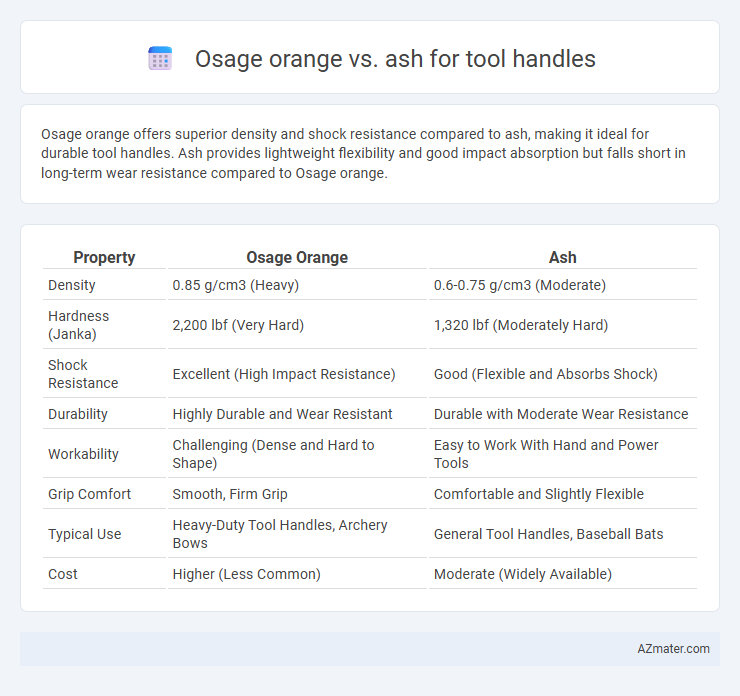Osage orange offers superior density and shock resistance compared to ash, making it ideal for durable tool handles. Ash provides lightweight flexibility and good impact absorption but falls short in long-term wear resistance compared to Osage orange.
Table of Comparison
| Property | Osage Orange | Ash |
|---|---|---|
| Density | 0.85 g/cm3 (Heavy) | 0.6-0.75 g/cm3 (Moderate) |
| Hardness (Janka) | 2,200 lbf (Very Hard) | 1,320 lbf (Moderately Hard) |
| Shock Resistance | Excellent (High Impact Resistance) | Good (Flexible and Absorbs Shock) |
| Durability | Highly Durable and Wear Resistant | Durable with Moderate Wear Resistance |
| Workability | Challenging (Dense and Hard to Shape) | Easy to Work With Hand and Power Tools |
| Grip Comfort | Smooth, Firm Grip | Comfortable and Slightly Flexible |
| Typical Use | Heavy-Duty Tool Handles, Archery Bows | General Tool Handles, Baseball Bats |
| Cost | Higher (Less Common) | Moderate (Widely Available) |
Introduction to Osage Orange and Ash Wood
Osage orange wood is renowned for its exceptional density, durability, and resistance to wear, making it an excellent choice for tool handles that require toughness and long-lasting performance. White ash, valued for its strong, shock-absorbent properties and straight grain, offers a lightweight yet sturdy option ideal for ergonomic tool handles. Both woods provide unique advantages in strength and workability, with Osage orange excelling in hardness and Ash prized for its flexibility and ease of shaping.
Key Properties of Osage Orange for Tool Handles
Osage orange is highly valued for tool handles due to its exceptional density and hardness, providing superior strength and durability compared to ash. Its natural resistance to wear and shock absorption minimizes handle breakage under heavy use. The wood's tight grain structure also offers excellent grip and reduces splintering, making it an ideal choice for long-lasting, reliable tool handles.
Key Properties of Ash for Tool Handles
Ash wood is prized for tool handles due to its exceptional strength, flexibility, and shock resistance, making it highly durable during heavy use. Its open grain structure provides a good grip and reduces the likelihood of splintering under stress. Compared to Osage orange, ash offers a lighter weight and superior impact absorption, enhancing user comfort and control.
Strength and Durability Comparison
Osage orange offers exceptional strength and durability due to its dense, hard grain, making it highly resistant to wear and impact for tool handles. Ash provides excellent shock resistance and flexibility, featuring a balanced combination of toughness and durability but is generally less dense than Osage orange. Compared to ash, Osage orange tool handles tend to last longer under heavy use, making it a superior choice for applications requiring maximum strength and longevity.
Flexibility and Shock Absorption
Osage orange offers exceptional shock absorption due to its dense, interlocked grain, making it highly resistant to impact and ideal for tool handles requiring durability. Ash, known for its superior flexibility and straight grain, provides better bending resistance and comfort during prolonged use. Choosing between Osage orange and ash depends on whether the priority is maximum shock absorption or enhanced flexibility for tool handle performance.
Weight and Balance Considerations
Osage orange wood is significantly denser and heavier than ash, offering a solid and durable feel for tool handles that demand high impact resistance. Ash provides a lighter weight alternative with excellent shock absorption and balance, making it preferable for tools requiring swift maneuvers and reduced fatigue. Choosing Osage orange enhances handle strength but may affect balance, whereas ash delivers optimal weight distribution and comfort during extended use.
Workability and Shaping Differences
Osage orange offers exceptional durability and resistance to wear, making it ideal for heavy-duty tool handles but is denser and harder to shape compared to ash. Ash is renowned for its excellent workability, allowing for easier carving, shaping, and finishing due to its straight grain and moderate hardness. The coarse texture of ash facilitates smooth sanding and less tool resistance, whereas Osage orange requires more effort but provides superior shock absorption and impact strength.
Resistance to Environmental Factors
Osage orange exhibits superior resistance to environmental factors such as moisture, decay, and insect damage compared to ash, making it highly durable for tool handles exposed to harsh conditions. The dense and oily fibers of Osage orange reduce water absorption, preventing swelling and warping, whereas ash tends to absorb more moisture and degrade faster. While ash provides flexibility and shock absorption, Osage orange's enhanced resistance ensures longer-lasting performance under varying weather and usage scenarios.
Cost and Availability of Each Wood
Osage orange wood is generally more expensive and less readily available than ash due to its limited commercial harvesting and slower growth rate. Ash is widely accessible and cost-effective, making it a popular choice for tool handles in both professional and DIY markets. The high density and durability of Osage orange justify its higher price for specialized tools, whereas ash offers a balanced combination of affordability and workability.
Best Applications for Osage Orange and Ash Handles
Osage orange excels in tool handles requiring exceptional strength and durability due to its dense, shock-resistant wood, making it ideal for heavy-duty applications like axes and hammers. Ash offers a balance of toughness and flexibility, favored in handles for tools such as baseball bats and garden tools where vibration absorption and comfort are essential. Both woods provide superior grip, but Osage orange stands out for wear resistance, while ash is preferred for resilience under repeated bending stress.

Infographic: Osage orange vs Ash for Tool handle
 azmater.com
azmater.com